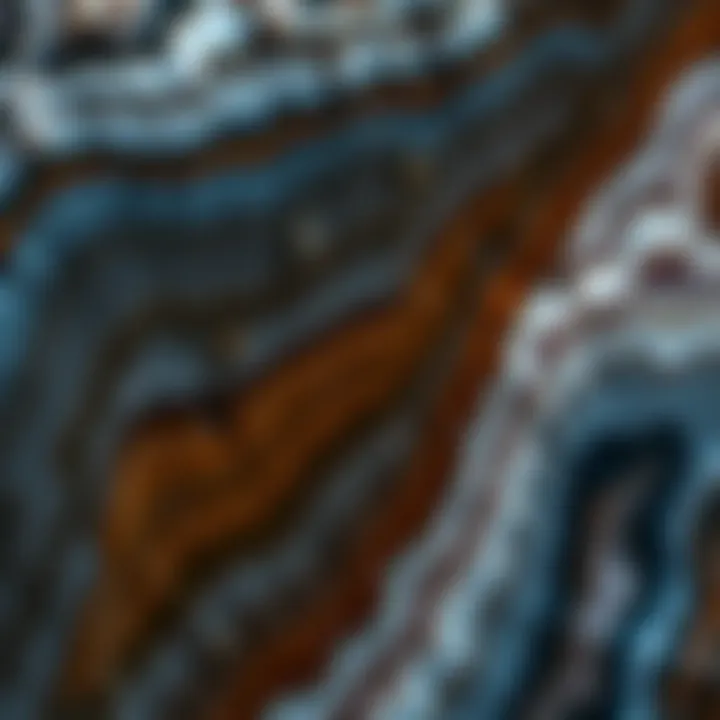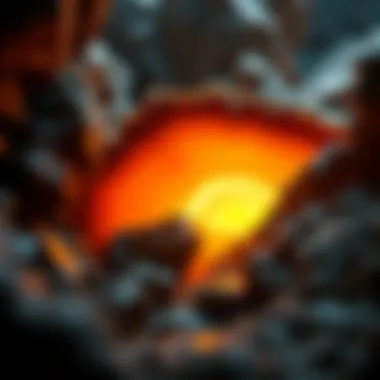Exploring the Fascinating World of Agate Rocks


Intro
Agate rocks have captivated the hearts of many with their stunning patterns and diverse hues. This journey into the world of agate offers insights not only into its natural beauty but also into its fascinating properties and usages. The variety of agate found around the globe showcases nature’s artistry, making each piece a unique treasure.
From distinct formations that take centuries to develop, to their vital role in various cultural practices, agate serves as a window into the geological processes that shape our planet. For rock and mineral collectors, understanding agate is crucial to appreciating its beauty and significance in both geological and cultural contexts.
By delving into this exploration, we uncover everything from the formation of agate to its various types, uses, and its relevance to collectors. By the end, readers will not only have a grasp of what makes agate special but also a wider view into the world of rocks and minerals.
Featured Collectible of the Month
Overview
Each month brings a spotlight to a special agate collectible, focusing on its characteristics and appeal. This month, we highlight the Moss Agate, distinguished by its lush green patterns resembling mossy landscapes. Unlike other agates that showcase vivid color bands, moss agate's beauty lies in its intricate inclusions, which can range from shades of green and brown, inviting the viewer to study its depths, layer by layer.
Historical Significance
Moss agate has a rich history that dates back centuries. Ancient civilizations regarded it as a stone of wealth, often sought after by tribal cultures for its balancing energies and earthy aesthetics. Many believed it offered protection during warfare and was a symbol of prosperity.
Collectors today treasure Moss Agate not just for its beauty but also for these fascinating historical tales woven into its existence. The lore surrounding moss agate adds an additional layer of value for enthusiasts wanting to connect the aesthetic with cultural narratives.
Identification Techniques
Recognizing genuine agate requires an eye tuned to its unique characteristics. Mastering these identification techniques can significantly aid collectors in differentiating agate from other stones.
Visual Characteristics
When it comes to identifying agate, several visual cues can be of help:
- Banding: Look for the characteristic intricately banded patterns.
- Translucency: Agate is often semi-translucent. Shine a light through it. If light passes easily, it’s agate.
- Color Variety: Be mindful of the broad range of colors. Agate can come in every color of the rainbow, sometimes within the same stone.
Resources for Identification
For collectors wanting to deepen their knowledge, various resources are available:
- The Mineralogical Society of America provides great insights on minerals and identification.
- Online platforms like Reddit and related Facebook groups allow enthusiasts to share photos and ask for help in identifying specific finds.
- Educational sites such as wikipedia.org and britannica.com offer comprehensive information on different agate types and their geological backgrounds.
In summary, understanding agate rocks opens the door to not just collecting but also appreciating the natural world more deeply. Each stone tells a story, a snapshot of the earth's history, inviting us to explore further.
Foreword to Agate Rocks
Agate rocks are more than just eye-catching stones; they hold deep geological significance and cultural value. These beautiful formations provide a window into the Earth’s history and makeup, revealing much through their diverse appearances. In this article, we will navigate the intricate world of agate, starting from its fundamental definition and branching out into its historical relevance. Understanding agate rocks not only enriches one’s knowledge about geology but also enhances appreciation for natural artistry found in these unique stones.
Definition of Agate
Agate is a microcrystalline variety of silica, composed primarily of quartz. These rocks are characterized by their distinct banding patterns, a feature that captivates collectors and enthusiasts alike. The colors often range from earthy tones of browns and tans to vibrant hues of blue, red, or green. Unlike other stones, the formation of agate results from the gradual filling of cavities in volcanic rocks with mineral-rich solutions. This process contributes to their unique layered appearance and structural integrity, offering pieces that tell geological stories through time.
In technical terms, agate is termed as a type of chalcedony, noted for its fine, fibrous arrangement. Agate is dense and has a Mohs hardness of 6.5 to 7, making it durable enough for various uses, from jewelry to decor. When discussing agate, one must recognize its role in geology—not just as an aesthetically pleasing specimen, but also as an illustrative piece of the natural world.
Historical Context
Historically, agate has captured the human imagination across civilizations and epochs. Ancient Egyptians utilized agate in jewelry as early as 3000 BC, believing that it provided protective qualities and imparted courage. The stone’s mesmerizing patterns inspired artisans to craft intricate carvings, often associated with power and protection. In ancient Rome, agate was considered a talisman against danger and misfortune, signifying its importance as more than just a decorative stone.
In different regions, such as the Middle East and India, agate has been associated with various sacred beliefs and practices. The very name "agate" is derived from the Achates River in Sicily, where this stone was first discovered. Over time, collectors and mineral enthusiasts have sought out agate not just for its physical beauty but for its rich tapestry of history.
Throughout different cultures, agate has been celebrated as a means to ground oneself, often thought to stabilize emotional energy. This cultural layering adds depth to the appreciation of agate, transcending its physical properties and embedding it into the fabric of human experience.
"Agate's profound history and complex formation process provide a unique lens through which we can study not just the Earth, but the interwoven tales of humanity."
Through this comprehensive exploration of agate rocks, we aim to shed light on their geological, historical, and emotional significance, creating a deeper connection for those curious about these stunning geological creations.
Geological Formation of Agate
Agate formation is an intricate process that highlights the dynamic interactions between minerals, water, and geological activity. Understanding this topic is crucial not only for geologists but also for collectors who appreciate the intricate beauty and unique formations of agate stones. The geological processes involved in the formation of agate provide a window into the Earth’s history, as well as insights into the environmental conditions that led to the creation of these remarkable stones. By delving into the specifics of this formation, one can better appreciate the magnificence of agate and its presence across various terrains and rocks.
Silica Content and Formation Process
At the heart of agate’s charm lies its composition. Agates are primarily made up of silica (SiO2), the same compound found in quartz. This silica content is the crux of the formation process. It primarily begins in fissures and cavities within volcanic rocks, where silica-rich fluids permeate through. As these fluids cool, the dissolved silica precipitates out, creating layers of quartz crystals over time.
A key element to visualize is the layering process itself. While some agates may show consistent structures, many display intricate banding patterns, a result of varying mineral deposits during the cooling period.
- Banding: Each layer can contain different colors and even textures, which often results from the presence of trace minerals such as iron, manganese, or cobalt.
- Cavities: This layering can also occur within existing cavities in the host rock, leading to the characteristic shapes seen in many agate specimens.


The gradual crystallization takes extensive geological time, often spanning thousands to millions of years. The conditions under which these minerals crystallize can vary significantly; changes in pressure, temperature, and fluid composition can all contribute to the final appearance of the agate. This makes each piece distinctly unique, akin to fingerprints in the world of geology.
Role of Volcanic Activity
Volcanic activity plays a pivotal role in agate's formation. Many agates originate from basaltic lava flows, where explosive volcanic eruptions create a fertile ground for silica-rich deposits. During such events, as magma rises towards the surface, gases and vapors get trapped within, forming bubbles or voids when the lava solidifies.
These voids serve as the nascent spaces where agate can form, as aforementioned silica-rich solutions seep in over time. The dynamics of volcanic activity influence more than just the creation of the agate itself:
- Source Material: The original lava provides the minerals needed for the agate’s formation.
- Elevation of Agate Presence: Eruptions can push these formations closer to the surface, making them more accessible for discovery and excavation by collectors.
"Volcanic origins provide not just the canvas but a living history in each agate piece, telling tales of ancient eruptions and geological shifts."
Understanding these geological processes not only gives agate its beautiful physical properties but also underlines its importance as a record of geological history. The very properties that make agate precious are woven into its genesis, painting a picture of transformation, time, and the Earth’s ever-evolving crust.
Types of Agate
Understanding the different types of agate is essential for anyone delving into the fascinating world of these unique minerals. Each type exhibits distinct characteristics and offers various benefits that cater to collectors, jewelers, and those fascinated by geological formations. By discussing the banding patterns and common varieties, this section seeks to highlight how these agate types contribute to their appeal and significance.
Banding Patterns and Colors
Agate is particularly renowned for its banding—these colorful layers often tell a story of its formation. Typically, the bands might vary in color from milky whites to deep reds, greens, or blues, each representing different mineral contents and environmental conditions during its formation. The specific colors and patterns create a visual delight, making agate a popular choice among collectors. Not only do these patterns enhance the visual aesthetic, but they also allow for deeper investigation into the geological history of the stones.
"The colors in agate serve as a roadmap, leading us back through time to understand the natural processes at play in the Earth’s crust."
This character of agate underlines the importance of understanding banding patterns, as they inform potential buyers about the stone’s origin and quality.
Common Varieties of Agate
When one mentions agate, several distinct varieties come to mind, and each of these has its unique stories and characteristics.
Moss Agate
Moss agate is often cherished for its beautiful green patterns resembling moss, thus earning its name. This variety is primarily chalcedony with inclusions of minerals like iron or manganese giving it a rich, earthy color. Moss agate is known for its calming and grounding properties, making it a popular choice among those who appreciate not just its aesthetic but also its metaphysical benefits. Collectors often favor it for its unique appearance—no two pieces are exactly alike, which adds to its allure.
From a geological standpoint, the presence of these inclusions can make moss agate more intriguing, inviting curiosity about its formation process and the environment in which it was created.
Fire Agate
Fire agate is another captivating variety of agate that captures interest due to its stunning, iridescent surface that seems to glow with a fiery brilliance. This variety is often darker, with rich browns and reds, and displays an optical phenomenon known as "play-of-color" similar to opals. Due to its striking appearance, fire agate can often command higher prices among collectors.
However, its more fragile nature may pose a challenge; care has to be taken when setting these stones in jewelry to prevent chipping. Still, the visual impact often outweighs these considerations.
Blue Lace Agate
Blue lace agate comes in delicate, light blue hues often characterized by its soft, flowy bands. This variety is soothing to the eye and is frequently used in jewelry pieces designed to convey tranquility. Collectors appreciate it for its ethereal feel and promise of peace; it’s a preferred choice for those interested in the healing properties of stones.
Beyond the aesthetics, blue lace agate's light coloration often makes it easier to work with in various settings, which can be advantageous in jewelry designing. However, it can be less durable than darker varieties, which is a factor to consider.
Picture Agate
Picture agate is famous for its striking patterns that mimic landscapes or natural scenes, commonly resembling clouds, mountains, or trees. The unique formations found in each piece make them highly sought after, particularly by collectors who appreciate artistic value in stones. Each stone is like a canvas; thus, the value can increase with the complexity and beauty of the 'picture' it presents.
The only challenge with picture agate is the necessity for careful observation when selecting pieces; not every pattern will resonate equally with collectors or artists. Still, its potential to inspire creativity is significant, enriching the artistic spirit in whatever application it finds.
Physical and Chemical Properties
The physical and chemical properties of agate rocks illuminate their significance in both geology and the field of mineralogy. These properties provide essential insights that not only help in identifying and classifying various agate types but also in understanding their applications and potential worth. A well-rounded grasp of these aspects can be quite beneficial for collectors as they navigate the diverse world of agate.
Hardness and Density
Agate belongs to the quartz family and showcases a significant hardness, typically rated at 6.5 to 7 on the Mohs scale. This characteristic makes it quite resilient, allowing it to withstand weathering and erosion compared to softer minerals. The density of agate usually ranges between 2.6 to 2.7 g/cm³, qualities that contribute to its desirability. Collectors often favor agate for its durability, making it an excellent choice for jewelry and functional items alike. This hardness also means that aspects like polishing and finishing can result in a lovely sheen while maintaining structural integrity. For many rock enthusiasts, the combination of hardness and density presents a captivating aspect of agate, fueling further interest and collection.
Optical Properties
When it comes to optical properties, agate shines . . . quite literally. Most agates exhibit a translucent to opaque appearance, offering stunning color plays and banding patterns that captivate the eye. The refractive index of agate generally falls around 1.54 to 1.55, which contributes to the unique way light interacts with this mineral. Different types can present varying levels of clarity, but it is these very optical characteristics that often allure collectors. The banding creates layers that can seem to tell a story of geological history, making each piece a unique tale of time itself. Collectors are often greatly enchanted by these optical traits, as they deliver both aesthetic beauty and geological significance.
Chemical Composition
From a chemical standpoint, agate primarily comprises silicon dioxide (SiO₂), a compound that plays a crucial role in its formation and categorization. This chemical composition can vary slightly due to the presence of impurities, such as iron oxides, which may impart specific hues like reds or browns, while the presence of manganese compounds can yield pinks or purples. Understanding agate's chemical composition isn't just an academic pursuit; it's essential for collectors who seek to identify specific varieties or determine the best way to care for their collections. Knowledge of the elemental makeup comes in handy, especially when it involves preservation, enhancing both the item’s longevity and value.
"The unique interplay of physical and chemical properties in agate ensures that each piece is not merely a rock but a window into the geological forces that shaped it."


The physical and chemical properties of agate rocks are multifaceted and essential for anyone interested in geology or mineral collection. The hardness and density of agate pave the way for its durable characteristics; while optical properties offer a visual feast that enchants collectors. Lastly, understanding the chemical composition ties everything together, enabling aficionados to make more informed choices about the preservation and valuation of their prized pieces.
Uses of Agate in Various Industries
Agate rocks have carved out a unique niche across various industries, stemming from their aesthetic appeal and remarkable physical properties. This section delves into the origiins and significace of agate's usage spanning from ancient collectible jewelry to modern architectural designs, showcasing its versatility and timeless charm. Each industry harnesses agate's qualities in special and profitable ways, making it an intriguing subject for rock enthusiasts and professionals alike.
Jewelry and Ornamentation
In the realm of jewelry, agate shines as a versatile gemstone prized for its beautiful colors and intricate patterns. Artisans and designers have utilized agate's raw beauty for centuries, converting rough nodules into stunning beads, pendants, and earrings. These pieces stand out not only for their aesthetic qualities but also for their meaningful representations. Agate jewelry is often associated with protection and stability, making it popular among those who value both fashion and significance.
Agate's varied banding patterns reflect a wide range of style preferences. From bold to subtle designs, the unique formations present in each piece ensure that no two items are identical. Some collectors specifically seek out particular varieties like Moss Agate or Fire Agate, enhancing their collections while benefitting from the stones' claimed metaphysical properties. Customizations, such as engraving and shaping, further amplify agate's adaptability in the creation of statement pieces.
Healing and Metaphysical Properties
Agate has long been regarded as a stone of strength and stability. Many practitioners in the metaphysical community believe that agate possesses grounding qualities that can help individuals achieve emotional balance. These claims have led to a surge in its usage in alternative healing practices. Stones are often used in meditation, energy work, and as talismans.
Here are some commonly cited benefits of agate in healing:
- Stress Reduction: Many believe that agate can help reduce stress and promote calmness, encouraging a balanced emotional state.
- Physical Well-being: Some claim that wearing or carrying agate can aid in physical ailments, such as digestive issues.
- Confidence: The stone is thought to bolster confidence, clarity, and motivation when facing challenges.
Agate's healing attributes are widely acknowledged in the crystal healing community, where it is used to enhance the flow of positive energy and dispel negativity. This fusion of its physical properties with spiritual significance underscores why agate is not merely a decorative item but a stone believed to enrich one’s life.
Utilization in Architecture
Beyond personal adornments and spiritual practices, agate's striking visual appeals have found a home in architecture and interior design. Designers frequently incorporate agate into modern buildings and luxurious interiors, using large slabs as wall decorations, countertops, and unique flooring materials. The resilient nature of agate makes it not just beautiful but also functional, offering durability against wear and tear.
One remarkable feature of architectural agate is its ability to transform light. When polished, agate can delicately diffuse light, creating stunning effects in both natural sunlight and artificial illumination. This characteristic allows architects to play with designs effectively, creating captivating atmospheres.
Moreover, the rise of sustainable design has brought agate's organic formation process into the limelight, making it more appealing to eco-conscious designers. Local sourcing practices further support this shift, as many companies strive to use responsibly harvested materials.
"Agate is not just a stone; it’s a partnership of nature and craftsmanship that captivates us."
Cultural Significance of Agate Rocks
Agate rocks have been cherished across various cultures and time frames, holding significant meaning far beyond their aesthetic allure. As we delve into the cultural narratives, it’s clear that these stones serve not only as decorative objects but also as bearers of deep symbolic weight and historical representation. Their unique characteristics, often tied to origin stories, create a bridge between natural history and human experience.
Myths and Legends
From the dawn of civilization, agate finds its place in myths and legends. Ancient societies often attributed mystical powers to this rock. The Greeks believed agate could enhance strength, making it a prized item in battle attire. Stories circulated about warriors who carried agate amulets into war, convinced that the stones would protect them from harm. Similarly, Native American tribes revered agate as a stone of protection and healing, often using it in rituals.
In various ancient texts, agate was said to possess tangible powers to ward off demons and trade misfortunes. Some legends even suggest that agate can enhance fertility and promote marital harmony. These beliefs conveyed a broader appreciation for agate, which went beyond mere decoration.
One particularly fascinating myth traces the use of agate back to the ancient Egyptians, who utilized it in scarabs – symbols of endurance and protection in the afterlife. Such legends underscore agate's roles in spiritual practices, showing how humanity has forever sought a connection to the cosmos through stones like these.
Symbolism Across Cultures
Throughout history, agate has transcended mere utility to symbolize various ideals and emotions. In many cultures, different colors of agate have distinct meanings. For instance, blue lace agate is often associated with tranquility and communication, a reflection of its delicate patterns resembling clouds in the sky.
Conversely, fire agate, with its rich hues and mesmerizing patterns, is seen as a stone of passion and vitality. Many have adopted it for fostering creativity and enhancing one’s zest for life. These diverse interpretations illustrate how agate has woven itself into the fabric of cultural identity worldwide.
"Agate is not just a stone; it’s a multifaceted story that connects us to our past, our beliefs, and ourselves."
In Asia, particularly in countries like India and China, agate is integrated into traditional practices like Feng Shui and is often used in jewelry to attract good fortune. In recent years, with the rise of gemstone therapy, agate has regained prominence, as people seek holistic approaches to healing—tying past symbolism to modern wellness.
Collection and Preservation of Agate
Collecting agate rocks can be as rewarding as it is intriguing. It’s not merely about gathering stunning specimens, but also ensuring their longevity for future enjoyment. The act of collection involves a unique blend of passion, patience, and an understanding of the natural world. While the beauty of agate captivates many enthusiasts, the proper care and preservation of these stones can dramatically enhance their value, both sentimental and monetary.
Tips for Collectors
When embarking on the journey of agate collection, certain considerations can help you curate an impressive assortment. Here are some practical tips:
- Know Your Locations: Identify local areas where agate is commonly found. Quarry sites, riverbeds, and even online marketplaces can yield fruitful finds. Some renowned spots include the beaches of Oregon, the Lake Superior region, and the Badlands of South Dakota.
- Study the Varieties: Get familiar with the different types of agate: moss, fire, lace Each has distinct features worthy of attention. For example, picture agate is celebrated for its stunning visual patterns, resembling a landscape.
- Invest in Quality Tools: A geologist’s hammer, safety goggles, and a sturdy bag are essential. Proper tools ensure that you can collect thoughtfully without damaging your finds.
- Join a Group: Engaging with a community of collectors can provide insight and tips on the best practices in the field. Websites like reddit.com often host discussions about collecting.
- Document Your Finds: Keep records of where each piece was found. This information adds story and value to your collection. Photos, dates, and locations can make your collection even more meaningful.
Maintenance and Care
Once your agate collection is in hand, you’ll want to maintain it properly to preserve its beauty and integrity. Below are some beneficial practices to consider for the ongoing care of your rocks:
- Gentle Cleaning: Avoid harsh chemicals or abrasive materials when cleaning. Instead, use soapy water and a soft brush to gently remove dirt and grime.
- Storage Solutions: Keep your agates in a dark, cool place. Avoid direct sunlight as it could lead to fading over time. Consider using padded compartments in boxes or soft cloth bags to prevent scratches.
- Avoiding Humidity: Too much moisture can lead to deterioration. Use silica gel packets in storage areas to absorb excess humidity.
- Handling with Care: When showcasing your collection, handle each piece with clean hands. Oils and dirt from fingers can leave residues on the stones.
- Periodic Checks: Regularly inspect your collection for any signs of damage or wear. Early detection can prevent further deterioration and ensure you keep your display looking pristine.
"A rock's beauty is less about its shape and more about its history. Treat it right and it will reflect the story of its journey."


By following these guidelines, collectors will not only boast a remarkable agate collection, but also contribute to its enduring significance for future generations. The care invested in each piece can transform mere rocks into cherished heirlooms.
Comparison with Other Rocks
Understanding how agate compares with other rocks is not just a matter of academic interest. It's a vital element for rock collectors and enthusiasts who wish to identify, categorize, and appreciate the nuances of their specimens. Each rock type presents unique characteristics, and this comparison sheds light on those differences that can enhance someone’s appreciation for agate and its place within the larger family of silica-based minerals.
Difference Between Agate and Jasper
Agate and jasper are often lumped together in casual conversation due to their similar appearance, but they are distinct in several significant ways. Both are varieties of chalcedony, yet their textural and compositional differences set them apart quite clearly.
- Color and Patterns: Agate typically features translucent bands in various colors. These bands can give agate its characteristic swirling designs. In contrast, jasper is generally opaque and displays mottled patterns rather than distinct banding. Imagine anything frosty against a solid, earthy tone; that pretty much sums it up.
- Formation and Composition: Agate forms from the deposition of silica in volcanic or sedimentary environments, often in a spherical shape. Jasper, on the other hand, is an aggregate of fine-grained quartz and is commonly formed under lower temperature and pressure conditions. An important takeaway is that the formation processes can affect the durability and usage of each rock.
- Usage in Crafting: While both stones can be crafted into jewelry, agate is more sought after for its ornamental qualities with its vibrant banding attracting attention. Jasper, with its earthy hues, is often favored for carving or creating more rustic art pieces.
The differences might appear subtle at first glance, but for collectors, knowing these can aid significantly in proper identification as well as enhancing the overall enjoyment of their collections.
Distinguishing Agate from Chalcedony
When you think of chalcedony, it’s critical to remember that this term describes a vast group of cryptocrystalline quartz varieties, of which agate is just one. Chalcedony’s striking array of colors and forms can confuse those not familiar with the specifics.
- Appearance and Structure: Agate is characterized by its distinctive banding; however, it falls under the broader umbrella of chalcedony. While some chalcedony varieties may exhibit a similar look to agate, they often lack the unique layered quality. Think of agate as a grand performance, while other chalcedonies are individual notes in a musical piece.
- Clarity and Translucence: Agate’s banded designs are always translucent, allowing light to pass through in varying degrees. Many other chalcedony types, like jasper or onyx, might be more opaque without the same light interplay. This factor is especially useful when evaluating specimens in natural sunlight.
- Hardness: Both agate and chalcedony score similarly on the Mohs hardness scale, ranking at about 6.5 to 7.0, meaning they are durable, but unique properties in terms of fracture and breakage can surface when subjected to different conditions.
The distinction between so-called sacred agate and chalcedony is often discussed amongst rock enthusiasts, and recognizing that one is an extension of the other can inform everything from buying decisions to artistic inspirations. Understanding these differences not only enriches one’s rocks and minerals collection but also fosters a deeper appreciation for the geological wonders of our planet.
Just like knowing the score in a ball game can change how you watch, understanding these differences in rocks can completely alter how someone perceives a collection.
For further exploration, you may find additional resources on the geological features of these minerals helpful:
- Wikipedia on Chalcedony
- Britannica on Agate
- Reddit Community on Mineral Collecting: Reddit
With this knowledge, let’s forge ahead to appreciate the remarkable distinctions showcased by agate, enriching our understanding of both aesthetics and geology.
Scientific Studies and Research
Research into agate rocks presents crucial insights that extend beyond their aesthetic charm. The study of agate is significant as it not only enhances our understanding of geological formations but also contributes to various innovative applications in science and industry. Exploring recent findings and practical applications provides a gateway for rock enthusiasts to appreciate both the beauty and the utility of these remarkable stones.
Recent Findings in Agate Research
Recent studies have added layers of depth to our understanding of agate formation and characteristics. Insights into chemical compositions have revealed that the specific trace minerals found in agates can vary widely, affecting their coloration and patterns. For instance, scientists have been investigating variances in quartz crystalline structures and the role of fluid inclusions in agate formation.
In a notable study published in the Journal of Minerals, researchers examined the correlation between the geographic origins of agates and their physical properties, such as density and hardness. They discovered that certain igneous and volcanic activities contributed to the unique banding patterns found in agate, which is directly relevant for collectors seeking specific traits.
Moreover, ongoing studies are focusing on how environmental factors influence agate deposits over time. These findings can serve practical purposes in fields like geology and paleoclimatology, as understanding natural resource distribution and changes can inform broader environmental research.
Applications of Agate in Modern Science
Agate's unique structural properties have led to innovative uses across various scientific disciplines. For example, in material science, the hardness of agate makes it an excellent candidate for precision tools. Researchers have been experimenting with agate as a material for abrasion-resistant surfaces, potentially revolutionizing industries that rely heavily on durable materials.
Additionally, agate’s rich optical properties have drawn interest from the field of photonics. Its ability to manipulate light can aid in developing new optical devices, including fiber optics. The interest in incorporating agate into advanced technology heralds a shift in how natural materials can be utilized creatively in science.
- Geology: Understanding agate deposit formation aids resource management.
- Metrology: Utilizing agate as a hardness reference scale in laboratories.
- Art: Leveraging agate's aesthetic for innovative designs in scientific instruments.
Agate is not just a gem used for decorative purposes; it bridges gaps in modern science, reflecting the modern pursuit of integrating natural materials into high-tech applications.
The fusion of ancient geology with modern scientific application highlights the ongoing relevance of agate in both natural history and contemporary research.
The End
In summarizing the exploration of agate rocks, one must consider not just their aesthetic appeal but also their profound geological significance and versatility across various domains. Understanding agate isn't merely an academic exercise; it's about appreciating the intricate narratives that these stones tell, derived from countless years of geological processes. Those who delve into agates often find themselves not only intrigued by their beautiful patterns and vibrant colors but also educated about the natural world.
The benefits derived from agates extend beyond personal enjoyment. Many collectors and enthusiasts have discovered the therapeutic and metaphysical attributes that these stones are believed to hold. For instance, moss agate is famed for nurturing growth and abundance, while fire agate is said to usher in motivation and courage. This blend of beauty and alleged utility underscores the importance of recognizing agate as more than a mere decorative piece, but as a symbol of cultural heritage and scientific marvel.
"To understand agate is to embrace nature's artistry and geological storytelling."
Collectors need to consider not only how they source and preserve these stunning specimens but also the broader implications of environmental and ethical practices in their acquisition. In the age of information, awareness of the origins and extraction methods becomes an indispensable part of the collector's journey.
Summary of Key Points
- Geological Importance: Agate forms through natural processes involving silica and volcanic activity, making them fascinating subjects of study within geology.
- Variety of Types: The range of agate types, such as moss agate, fire agate, and blue lace agate, illustrates the mineral's aesthetic diversity and geological richness.
- Cultural Significance: Throughout history, agate has been revered in various cultures for its symbolic and healing properties, enriching its importance beyond physical appearance.
- Collector Insights: Proper collection techniques and preservation practices are essential for maintaining the integrity of agate specimens, ensuring they endure for future generations.
- Scientific Research: Recent studies showcase the innovative applications of agate in modern science, highlighting its relevance in fields like material science.
Future Prospects for Agate
Looking ahead, the future of agate rocks appears promising, particularly in the realms of both scientific research and personal collections. As environmental awareness grows, there is an increasing emphasis on sustainable mining practices and eco-friendly sourcing. This trend not only preserves the environmental integrity of mining sites but also enhances the perceived value of the stones among collectors and enthusiasts.
The push towards scientific advancement also means that agate may find new applications in technology and materials science. Research into the unique properties of agate could lead to innovations in fields such as electronics and construction, where the durability and insulative qualities of this stone may play a critical role.
Within the collector community, the evolution of online marketplaces allows for a wider distribution of rare agate specimens. Digital platforms and social media connectors, such as reddit.com and facebook.com, serve as hotspots for sharing find and learn from the experiences of others involved in collection and preservation.
The future landscape surrounding agate reflects a growing appreciation for natural beauty intertwined with ethical practices, scientific exploration, and cultural understanding. Collectors and researchers alike will continue to uncover the rich layers of stories that agate holds, promising exciting developments in our understanding and appreciation of these remarkable geological formations.



